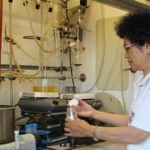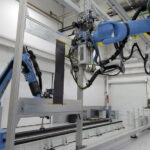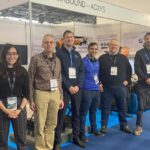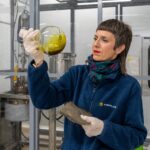NASA’s Glenn Research Center in Cleveland recently signed a commercial nonexclusive license agreement with Imitec Inc. of Schenectady, New York. The agreement includes development, manufacturing and distribution of NASA’s resin transfer moldable RTM370 imide resin to make the next generation of high-performance aerospace polyimides. RTM370 high-temperature material has a variety of potential applications ranging from aerospace applications – such as aircraft engines, space propulsion systems and missiles — to bushings and bearings for non-aerospace applications — such as oil drilling and rolling mills. “We are very happy to announce this partnership,” said Kim Dalgleish-Miller, chief of the Technology Transfer Office at Glenn. “The collaboration between NASA and Imitec opens excellent opportunities for creating impact in the marketplace and benefits to the economy.”
NASA and the aerospace industry need lightweight polymer composites to replace metal components, which would result in fuel efficiency and bigger payloads in aircraft and space transportation vehicles.
Dr. Chun-Hua “Kathy” Chuang, inventor of RTM370, is a chemical engineer in the Materials Chemistry and Physics Branch at Glenn.
Produced by a solvent-free melt process, these resins exhibit high glass transition temperatures (Tg = 370 to 400°C), low-melt viscosities (10 to 30 poise), long pot-life (1 to 2 hr), and can be easily processed by low-cost RTM and vacuum-assisted resin transfer molding (VARTM). These RTM resins melt at 260 to 280°C and can be cured at 340 to 370°C in 2 hr, without releasing any harmful volatile compounds.
This technology was developed to make polyimide resins from novel asymmetric dianhydrides (a-dianhydrides) and kinked diamines to achieve low-melt viscosities that are amenable to low-cost RTM and VARTM, while retaining high-temperature finished product performance above 300°C. These a-dianhydride-based RTM imide resins display low-melt viscosities (10 to 30 poise), which cannot be achieved using normal symmetric dianhydrides. RTM imide resins can be melted at 260 to 280°C, and injected into fiber preforms under pressure (200 psi) or vacuum (VARTM). The resins also can be made into powder prepregs with lengthy out-time by melting the resin powders so that they fuse onto fibers. RTM imide resins display high softening temperatures (370 to 400°C) and excellent toughness, as evidenced by the RTM370 resins open-hole compression strength. The resins also possess significant thermo-oxidative stability by long-term isothermal aging at 288°C (550°F) for 1000 hr. The unique melt process without a solvent provides a manufacturing advantage over the expensive high boiling solvents previously needed to produce oligomers. This process also eliminates the need for tedious and high-cost solvent removal.
Caption: Dr. Chun-Hua “Kathy” Chuang.
Credits: NASA













